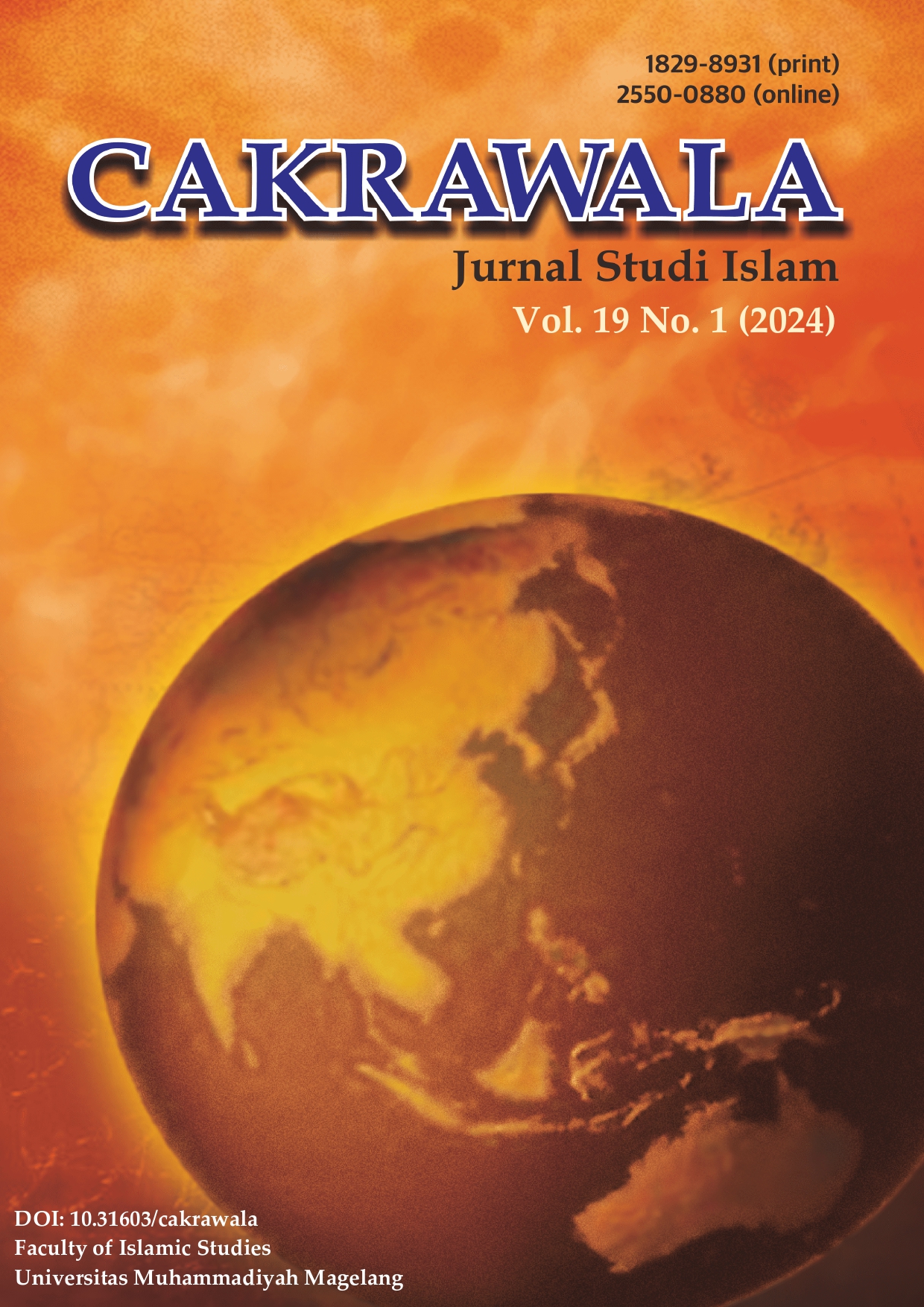Main Article Content
Abstract
Social integration between Muslim and Western societies reflects complex dynamics in intercultural relations involving two historically, culturally, and religiously distinct social realities. Various issues arise in the integration process between Muslim and Western societies, one of which is halal food labeling. This research examines how the halal discourse, particularly in the case of Midamar Corporation, shapes shared consciousness and influences social interactions between the two groups. Employing a qualitative approach, this study reveals that Midamar Corporation, as a key actor, plays a significant role in shaping the understanding of halal products and mediates the relationship between Muslim identity and consumption. The research findings indicate that the halal discourse is not merely a product label, but also a means of constructing identity and a space for negotiating meanings in a global context.
Keywords
Article Details

This work is licensed under a Creative Commons Attribution-NonCommercial 4.0 International License.
References
- Achmad, Z. A. (2020). Anatomi Teori Strukturasi dan Ideologi Jalan Ketiga Anthony Giddens. Translitera : Jurnal Kajian Komunikasi Dan Studi Media, 9(2), 45–62. https://doi.org/10.35457/translitera.v9i2.989
- Ajrouch, K. J. (2007). Global Contexts and the Veil: Muslim Integration in the United States and France. Sociology of Religion, 68(3), 321–325. https://doi.org/10.1093/socrel/68.3.321
- Anas, M., Saputro, A. R., & Wahdah, H. (2023). Persepsi Halal dan Pemahaman Sertifikasi Halal: Studi Deskriptif Analitik. Misykat Al-Anwar Jurnal Kajian Islam Dan Masyarakat, 6(1), 1–12. https://doi.org/10.24853/ma.6.1.1-12
- Dalhat, D. Y. (2015). Islam and the Problem of Social Integration in the West. International Journal of Education and Research, 3(7), 273–282.
- Editor Kumparan. (2023). 5 Tantangan Integrasi Nasional yang Dihadapi Bangsa Indonesia. kumparan.com. https://kumparan.com/sejarah-dan-sosial/5-tantangan-integrasi-nasional-yang-dihadapi-bangsa-indonesia-20Sndw82XA3
- Faturochman. (2009). Pengantar Psikologi Sosial. Pustaka.
- Grunow, D., Sachweh, P., Schimank, U., & Traunmüller, R. (2022). What We Have Learned About Social Integration: Conclusion. KZfSS Kölner Zeitschrift Für Soziologie Und Sozialpsychologie, 75(1), 415–430. https://doi.org/10.1007/s11577-023-00922-2
- Grunow, D., Sachweh, P., Schimank, U., & Traunmüller, R. (2023). Social Integration: Conceptual Foundations and Open Questions. An Introduction to this Special Issue. KZfSS Kölner Zeitschrift Für Soziologie Und Sozialpsychologie, 75(S1), 1–34. https://doi.org/10.1007/s11577-023-00896-1
- Harahap, D. (2024). Jumlah Restoran Halal di AS Meningkat Hingga 13 Ribu. mediaindonesia.com. https://mediaindonesia.com/weekend/577917/jumlah-restoran-halal-di-as-meningkat-hingga-13-ribu
- Harnadi, D. (2021). Menakar Potensi Sosiologi Hukum sebagai Pendekatan Perdamaian: Pembacaan dari Perspektif Strukturasi Giddens. Legal Studies Journal, 1(1), 70–83. https://doi.org/10.33650/lsj.v1i1.2024
- Indah, R. N. (2009). Mengenal Lebih Dekat Analisis Wacana dan Kajian Bahasa Kritis. Sekolah Linguistik.
- Johnson, D. P. (2008). Human Agency, the Structuration Process, and Social Systems: Linking Micro, Meso, and Macro Levels of Analysis. In Contemporary Sociological Theory (pp. 459–489). Springer New York. https://doi.org/10.1007/978-0-387-76522-8_17
- Kalsum, A. U., & Fauzan. (2019). Integrasi Sosial dalam Membangun Keharmonisan Masyarakat. JAWI, 2(1).
- Luthfia, A. (2014). Pentingnya Kesadaran Antarbudaya dan Kompetensi Komunikasi Antarbudaya dalam Dunia Kerja Global. Humaniora, 5(1), 9–22. https://doi.org/10.21512/humaniora.v5i1.2976
- Mais, Y., & Purwanto, A. (2019). Integrasi Sosial antara Masyarakat Pendatang dengan Masyarakat Setempat di Desa Trans Kecamatan Sahu Timur. HOLISTIK, Journal of Social and Culture, 12(1), 1–19.
- Midamar. (2024). About Midamar. https://www.midamar.com/about-us
- Putra, R. A., Laksmi, L., & Wijayanti, L. (2021). “Arena” di dalam Perilaku Pencarian Informasi untuk Mendapatkan Lagu: Pendekatan Grounded Theory. Jurnal Ilmu Informasi, Perpustakaan, Dan Kearsipan, 23(1). https://doi.org/10.7454/JIPK.v23i1.003
- Rumawi, R., & Munawiroh, A. (2021). Komodifikasi Label Halal Produk Pangan di Ruang Publik Perspektif Fatwa Majelis Ulama Indonesia. 5th Annual Conference on Fatwa Studies, 629–649.
- Sartika, D., Gurning, F. L., Chairunisa, P., Batubara, D. P., Tobing, D. L., Sitanggang, A., Saragih, O. A., Wuwu, A. F., & Prayetno. (2023). Populisme dan Tantangan Integrasi Masyarakat di Perumnas Mandala: Reaktualisasi Pancasila Sebagai Solusi. Indonesian Journal of Multidisciplinary Scientific Studies, 1(3), 29–33.
- Shafie, A., Nazri, M. A., & Hussin, H. (2019). Makanan Halal Menurut Perspektif Islam dan Kepentingan Pelabelan. BITARA International Journal of Civilizational Studies and Human Sciences, 2(3).
- Smith, S. E., & Tallentire, V. R. (2023). Simulation for Social Integration. International Journal of Healthcare Simulation. https://doi.org/10.54531/tdzn8875
- Sudirmanto, S., & Yoserizal. (2019). Perilaku Mahasiswa Rantau di Pekanbaru (Studi Kasus Mahasiswa Pelalawan). Jurnal Online Mahasiswa (JOM) Bidang Ilmu Sosial Dan Ilmu Politik, 6(2).
- Tamariska, S. R., Lestari, A. D. E., Septania, E. N., & Ulum, M. S. (2019). Peran Ruang Komunal dalam Menciptakan Sense of Community Studi Komparasi Perumahan Terencana dan Perumahan Tidak Terencana. Jurnal Koridor, 10(1), 65–73. https://doi.org/10.32734/koridor.v10i1.1388
- VOA Indonesia. (2019). Berkembangnya Industri Makanan Halal di Amerika. voaindonesia.com. https://www.voaindonesia.com/a/berkembangnya-industri-makanan-halal-di-amerika/5178170.html
- Waharini, F. M., & Purwantini, A. H. (2018). Model Pengembangan Industri Halal Food di Indonesia. Muqtasid: Jurnal Ekonomi Dan Perbankan Syariah, 9(1), 1–13. https://doi.org/10.18326/muqtasid.v9i1.1-13
- Yusrizal, F., & Asmoro, A. Y. (2020). Dampak Sosial Budaya Pariwisata: Masyarakat Majemuk, Konflik dan Integrasi Sosial di Yogyakarta. Jurnal Pariwisata, 7(2).

